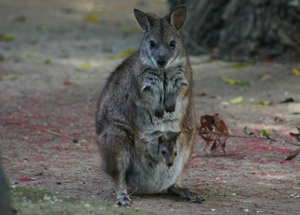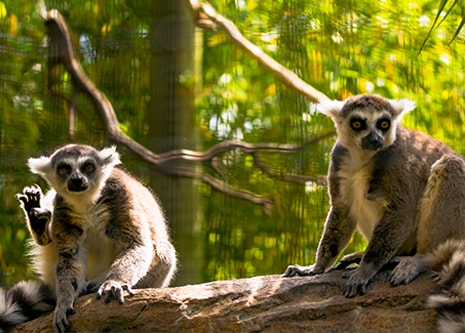
- VisitSupport Happy HollowDONATE TODAYExploreSupport Happy HollowDONATE TODAYLearnSupport Happy HollowDONATE TODAYSupportToday’s Hours: CLOSEDZoo in the Hollow
Parma wallaby

Scientific name: Macropus parma
Family: Macropodidae
Order: Diprotodontia
Class: Mammalia
Range: Mountain ranges in New South Wales, Australia; introduced population on Kawau Island, NZ
Habitat: Grassland, Temperate Forest and Rainforest
Lifespan: 7 to 10 years in the wild; up to 15 years in captivityWhat do they look like?
Parma wallabies are the smallest member of the genus Macropus, which includes all kangaroos and wallabies. They weigh 7 to 12 pounds and are around 18 to 20 inches tall, only one tenth the height of the red kangaroo. They are rather round in appearance when resting. Their fur is brown with lighter markings on their chest, neck, face and sometimes on the tip of their long tail. Parma wallabies have an elongated snout with a dark nose and eyes. Large rounded ears are located on either side of the top of the head.How do they behave?
Like all macropods (marsupials native to Australia which are members of the family Macropodidae), they move with a hopping gait, using their tail as a counterbalance. At rest they often sit “tripod style,” balanced on their two hind legs and tail. They have four digits on each forelimb but lack opposable thumbs. They have limited grasping ability, but enough to allow them to handle food. Parma wallabies prefer to live in wet sclerophyll forests, which have thick undergrowth and lots of grass, which they feed on. They are crepuscular (most active during dawn and dusk). In the wild, these wallabies usually live alone or in small groups.What do they eat?
Wallabies are herbivores. They graze on grasses, herbs, leaves, and the bark of trees and shrubs. At Happy Hollow they eat grass, fruits, vegetables, grain and hay.How are they born?
Like all marsupials, Parma wallabies rear their young, called joeys, in a pouch. A single joey is born after a 35 day gestation period and is usually the size of a jellybean. The blind, hairless joey crawls unaided from the birth canal to the pouch, where it attaches to a teat and remains there for the next five months. By that time, the joey is furred, alert and begins to exit the pouch to graze alongside its mother, often returning to the pouch for security and to suckle.Conservation
The conservation status of Parma wallabies is currently listed as Near Threatened by the International Union for Conservation of Nature . Parma wallaby populations are at risk due to different factors such as habitat loss and predation from foxes. The Australian government is currently working towards the protection of this species and other native wildlife. In 2014, Australia appointed its first-ever threatened species commissioner, whose job is to look after and preserve Australia’s native wildlife. One way Australia is working towards protecting their environment is through limiting their carbon emissions. You can help do this at home by doing things like walking to school or using public transportation. For more information about how you can help keep our air clean, visit http://www.sparetheair.org/
Zoo on the Hill
Located across from the Keep-Around Carousel is the Zoo on the Hill. Learn about wildlife up close during daily meet-and-greets, leap like a lemur on the playground, brush and feed the goats,, or take a peek inside Doc’s Critter Care building and the Ranch House. Double-H Ranch features a combination of animal exhibits, including giant anteaters and red ruffed lemurs, as well chickens and domesticated animals that are docile enough to touch.
See Animals
Education Ambassadors
From camps and classes to scout badges and sleepovers, Happy Hollow education programs have something for everyone! The zoo education program offers a broad range of hands-on, engaging programs and public presentations featuring education ambassador animals. These encounters are designed to connect you to wildlife and the conservation of their habitats around the world.
See AnimalsVisit Us Today
Plan an unforgettable experience at San Jose’s family-friendly park and zoo.
Learn More